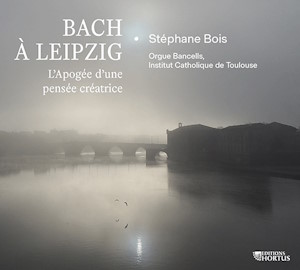
Johann Sebastian Bach (1685-1750)
Bach à Leipzig – L’Apogée d’une pensée créatrice
Ricercar à 6 voix BWV 1079 (1747)
Clavier-Übung III (extraits) (1739)
Chorals de Leipzig (extraits) (1723)
‘Vom Himmel Hoch’ BWV 701 (1739-42)
Variations Canonique sur ‘Vom Himmel Hoch’ BWV 769a (1747)
‘Vor dein Thron tret’ich hiermit’ BWV 668 (1723)
Stéphane Bois (organ)
rec. 2022, Chapelle Sainte-Claire de l’Institut Catholique de Toulouse
Notes provided in French and in an English translation.
EDITIONS HORTUS 226 [79]
This programme of Bach’s organ music concentrates on his output during the last ten years of his life, from 1739, when the Clavier-Übung III was published, which, as the excellent notes accompanying this issue, point out, was Bach’s final thoughts on the art of the chorale or the chorale prelude. His later chorale-based works were subtly different, less concerned with the liturgical necessity of providing a fitting introduction to the particular chorale about to be sung, but an exploration of various techniques of composition, such as canon. This had, in fact, begun in some of the examples included in the 1739 collection; the large-scale treatments of the chorales Dies sind die heilgen zehn Gebot and Vater unser im Himmelreich are included here and foreshadow the Canonic Variations on Vom Himmel Hoch. The selection of music has been skillfully made with each item serving to illuminate the next, culminating in the great set of canonic variations, followed by the final item which, if not perhaps the old Cantor’s deathbed composition as once was thought, was certainly likely to be among his last and was placed in the Art of Fugue where the final movement had been left unfinished.
Stéphane Bois is a polished and accomplished player whose approach is both thoughtful and musical. Nothing is done merely for effect. He uses the very characterful organ by Gérard Bancells, built in 1994 for l’Institut Catholique de Toulouse. Although quite a modest instrument of 27 stops over two manuals and pedals, it has all the tonal variety and character that this highly wrought music demands. Of particular interest is player’s interpretation of the Chorale Prelude Dies sind die heilgen zehn Gebot. Bach chooses to write this in compound time, with the unit being a triplet, thus creating a dance-like composition, apparently at odds with the seriousness of the subject matter and closer in style to a movement from one of the French or English Suites. This has tempted players to treat this prelude as a scherzo, using what might be described as ‘musical box’ registration and to recall the pieces for musical clocks written later by Mozart, Haydn and Beethoven. However, played, as here, on a reedy tutti, the piece really comes to life and shows that approaching it as though it were a miniature is entirely wrong and that, unsurprisingly, Bach really knew what he was doing. A most enjoyable disc.
Martyn Strachan
Availability: Editions Hortus


















